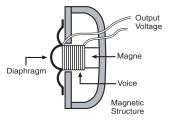Transducers and Microphones
The
primary thing to understand about microphones is that they are a transducer. A transducer is
something that changes energy from one form to another. In this
instance, the transducer in the microphone converts acoustic (sound)
energy into electrical energy.

Diagram courtesy of http://www.audio-technica.com/cms/site/b0d226992d31e25d/index.html
One of the most important parts of a microphone is the diaphragm, which sound affects in a similar way to the eardrum in the human ear. It is surrounded by a coil of wire and a magnet. What the electrical wire is connected to depends on whether or not the microphone is wireless. If it's wired, it's connected to a cable which is connected to something else like a computer or a stereo. If it's wireless, then it goes to transmitter.
When sound goes through the microphone, the sound pressure is changed, which causes the diaphragm to vibrate, and thus create a tiny electric current within the capsule. Specifically, it causes an alternating current, since the current goes in one direction when the diaphragm moves forward but moves in the opposite direction when the diaphragm moves the other way. This current creates electrical energy in the form of the audio signal, which travels through the wire.
The only difference in the condenser microphones is that it doesn't need a wire because it has a capacitor. A capacitor has two parallel plates of opposing charges. When the diaphragm moves, the air pressure creates a current between these two plates, which results in the audio signal.
This does not destroy any energy because of the Law of Conservation of Energy, which states that energy cannot be created nor destroyed.
Energy=E, Efinal-Einitial=0
The energy here has only changed its form; the energy in this process is not destroyed.
--------------------------------------------------------------------------------------------------------------------------------------------------------------------------------------------------------------

Diagram courtesy of http://www.audio-technica.com/cms/site/b0d226992d31e25d/index.html
One of the most important parts of a microphone is the diaphragm, which sound affects in a similar way to the eardrum in the human ear. It is surrounded by a coil of wire and a magnet. What the electrical wire is connected to depends on whether or not the microphone is wireless. If it's wired, it's connected to a cable which is connected to something else like a computer or a stereo. If it's wireless, then it goes to transmitter.
When sound goes through the microphone, the sound pressure is changed, which causes the diaphragm to vibrate, and thus create a tiny electric current within the capsule. Specifically, it causes an alternating current, since the current goes in one direction when the diaphragm moves forward but moves in the opposite direction when the diaphragm moves the other way. This current creates electrical energy in the form of the audio signal, which travels through the wire.
The only difference in the condenser microphones is that it doesn't need a wire because it has a capacitor. A capacitor has two parallel plates of opposing charges. When the diaphragm moves, the air pressure creates a current between these two plates, which results in the audio signal.
This does not destroy any energy because of the Law of Conservation of Energy, which states that energy cannot be created nor destroyed.
Energy=E, Efinal-Einitial=0
The energy here has only changed its form; the energy in this process is not destroyed.
--------------------------------------------------------------------------------------------------------------------------------------------------------------------------------------------------------------